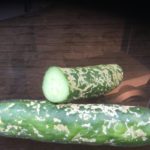I bought heirloom seedlings, and looking at the attached photos it looks like the main stem has a webbing as well as the baby and adult cucumbers. I am not sure if this is a disease, or just less resistant and therefore more marked up. It is an amiga cucumber. Should I rip them out of my garden or Can I continue to grow and eat them. Kitchener Ontario. Zone 5.

It looks like cucumber beetles have been feasting on your plants. These spotted or striped critters are also called “rindworms” as they feed on the surface of the fruits. If the damage to your cucumbers is limited to the rind, then just cut away the rind and eat the cuke. Otherwise discard it.
A more serious concern is that in some cases, these beetles can infect plants with bacterial wilt or mosaic disease, which can spread to other cucumber plants, as well as to other vegetable crops. If bacterial wilt occurs, there is nothing you can do – the leaves will quickly dry up and the plant will wilt and die. Cucumber mosaic disease is caused by a virus, and signs of this include mottled, wrinkled leaves that curl downward at the edges. The plant growth is stunted and any cucumber fruit produced may be grey-white in colour (sometimes called “white pickles”). If it looks like your plants have either of these diseases, the plants must be destroyed immediately to prevent spread. Don’t compost them, instead bag them for your City to remove on garbage day.
It is important to prevent these critters from returning next year. As they overwinter in garden debris, make sure you get rid of all debris from the area. This fall, till the soil in order to kill any eggs and larva that remain.
Next year, don’t plant your cucumbers until mid-June, by which time any adults that have overwintered in the soil/debris have dispersed. And it’s recommended to cover the young plants with floating row covers, which will physically prevent the beetles from accessing them. Remove the covers once the plants start to bloom, so that pollinating insects can reach them. Regularly inspect the plants (especially underneath) for beetles.
An alternative to using row covers is to spray the plants with kaolin clay and add a reflective surface under the plants – use a flat piece of aluminum foil under the seedlings, and make a slit to fit around each plant’s main stem.
You can also use companion planting to help protect the cucumbers. For example, tansy repels the beetles. As well, by planting certain flowers, like marigolds, calendula, sunflower, daisy, alyssum or the herb dill close by your cucumber crop, you will attract beneficial insects that will feed on the nasty cucumber beetles.
For more information, here are links to some excellent resources:
- University of Maryland Extension’s Cucumber Beetles: Spotted or Striped – Vegetables
- Utah State University Extension. Western Striped Cucumber Beetle, Western Spotted Cucumber Beetle
- Mother earth news. Organic Cucumber Beetle Control
- University of Connecticut Extension. Should I eat that?
All the best with your cucumber plants.

